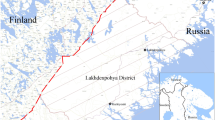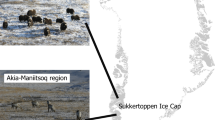Abstract
A comparative study of the major liposoluble antioxidant, vitamin E (α-tocopherol), content was conducted in carnivorous mammals (polar fox, silver fox, raccoon dog, mink, sable) in late autumn under naturally dropping temperature. The highest vitamin E content in the liver and kidney was found in the polar fox and raccoon dog, obviously due to seasonal metabolic changes and ecological specialization determining the accumulation of considerable amounts of tocopherol both in polar and hibernating species. To explore the features of vitamin E accumulation, a tocopherol-loading test was implemented on three species (polar fox, silver fox, mink). It was shown that the polar fox, as compared with the silver fox and mink, exhibits a higher ability to reserve vitamin E. The established differences in the tocopherol content and distribution pattern among different species should be considered as a genetically fixed reaction to the environmental impacts underlain by metabolic differences in animals with dissimilar ecological specialization. The ability of tocopherol to accumulate in tissues and organs allows considering its essential role in stabilization of the antioxidant system and ensuring thereby a seasonal cold resistance.
Similar content being viewed by others
References
Shilov, I.A., Fiziologicheskaya ekologiya zhivotnykh (Physiological Ecology of Animals), Moscow, 1985.
Menshchikova, E.B., Lankin, V.Z., Zenkov, N.K., Bondar, I.A., Kruglovykh, N.F., and Trufakin, V.A., Okislitel’nyi stress. Prooksidanty i antioksidanty (Oxidative Stress. Prooxidants and Antioxidants), Moscow, 2006.
Nadirov, N.K., Tokoferoly i ikh ispol’zovanie v meditsine i sel’skom khozyaistve (Tocopherols and Their Use in Medicine and Agriculture), Moscow, 1991.
Slonim, A.D., Uchenie o fiziologicheskikh adaptatsiyakh (Theory of Physiological Adaptations), In: Ekologicheskaya fiziologiya zhivotnykh. Ch. 1. Obshchaya ekologicheskaya fiziologiya i fiziologiya adaptatsii (Ecological Physiology of Animals, vol. 1, General Ecological Physiology and Physiology of Adaptations), Leningrad, 1979, pp. 79–182.
Kalabukhov, N.I., Spyachka mlekopitayushchikh (Hibernation of Mammals), Moscow, 1985.
Tumanov, L.I., Biologicheskie osobennosti khishchnykh mlekopitayushchikh Rossii (Biological Peculiarities of Carnivorous Mammals of Russia), St. Petersburg, 2003.
Skurikhin, V.N. and Dvinskaya, L.M., Identification of α-tocopherol and retinol in blood plasma of agricultural animals by microcolumn highthroughput liquid chromatography, Sel’skokhoz. Biologiya, 1989, vol. 4, pp. 127–129.
Khalmuradov, A.G., Totskii, V.N., and Chagovets, R.V., Transport zhirorastvorimykh vitaminov (Transport of Lipid-Soluble Vitamins), Kiev, 1980.
Schweigert, F.J. and Thomann, E., Organ distribution of vitamins A and E in carnivores, Scientifur., 1995, vol. 19, no. 4, p. 309.
Ilyina, T.N., Ruokolainen, T.R., Belkin, V.V., and Baishnikova, I.V., Tocopherol in physiological adaptations of mammals with different ecogenesis, Trudy KarNTs RAN, 2011, no. 3, pp. 49–56.
Shestopalova, L.V., Lavrinenko, V.A., and Vinogradova, M.S., Adaptive reactions of cellular structures of kidneys of the red-cheeked ground squirrel under hypothermia, Aktual’n. probl. ekol. fiziol., biokhim. i genet. zhivotnykh. Mezhdunar. nauch. konf. (Current Problems of Animal Ecology, Physiology, Biochemistry and Genetics. Proc. Internat. Conf.), Saransk, 2005, pp. 269–272.
Natochin, Yu.V., Water-salt homeostasis: evolution and ecology, Preprint Nauch. Dokl. na VI Vsesoyuzn. Konf. po Ekol. Fiziol. (Thesis for the VI All-Union Conf. Ecol. Physiol.), Syktyvkar, 1982, pp. 1–48.
Prestrud, P., Adaptation by the arctic fox (Alopex lagopus) to the polar winter, Arctic., 1991, vol. 44, no. 2, pp. 132–138.
Ilyukha, V.A., Superoxide dismutase and catalase in the organs of mammals of different ecogenesis, J. Evol. Biochem. Physiol., 2001, vol. 37, no. 3, pp. 241–245.
Beketov, S.V., Kazakova, T.I., and Chernova, I.E., Environmental conditions as a challenge for reproductive success of sables (Martes zibellina) with different fur coloration, Vavilov Zhurn. Genet. Sel., 2012, vol. 16, no. 4/2, pp. 1013–1024.
Voevoda, T.V. and Ustyuzhaninova, N.V., Morpho-functional peculiarities of the respiratory system in the polar fox, an arctic endemic, Byull. SO RAMN, 1997, no. 2, pp. 112–118.
Lee, C.-Y.J. and Wan, J.M.-F., Vitamin E supplementation improves cell-mediated immunity and oxidative stress of asian men and women, J. Nutr., 2000, vol. 130, pp. 2932–2937.
Gritsuk, A.I., Kader, A., Koval, A.N., Sergeenko, S.M., and Svergun, V.T., The influence of vitamins A, E, C on the respiratory activity in spleen lymphocytes, Vopr. Pitaniya, 2008, vol. 77, no. 1, pp. 26–29.
Skulachev, V.P., What is «Phenoptosis» and how to fight it?, Biochemistry (Moscow), 2012, vol. 77, no. 7, pp. 689–706.
Kolosova, N.G., Kolpakov, A.R., and Panin, L.E., Tocopherol content and lipid peroxidation in vistar rats tissues in the course of cold-adaptation, Vopr. Med. Khimii, 1995, vol. 41, no. 6, pp. 16–19.
Solomonov, N.G., Anufriev, A.I., Yadrikhinskiy, V.F., Okhlopkov, I.M., and Solomonova, T.N., Ecophysiological features of cold-tolerance in the mountain hare (Lepus timidus) in the northeast of Siberia, Dokl. Akademii Nauk, 2008, vol. 419, no. 6, pp. 846–849.
Schmidt-Nielsen, K., Animal Physiology: Adaptation and Environment, 2nd ed., Cambridge, 1975.
Kozhevnikova, L.K. and Berestov, V.A., Main regularities of metabolism in fur animals, Ocherki po fiziologii pushnykh zverei (Essays on the y of Fur Animals), Leningrad, 1987, pp. 4–39.
Alakhaya, M.Ya., Platonov, A.G., and Baizhumanov, A.A., Short-term cooling enhances the antioxidant status and overall resistance of animals, Byull. Eksper. Biol. Med. 2006, vol. 141, no. 1, pp. 31–34.
Cooney, R.V., Franke, A.A., Hankin, J. H., Laurie, J.C., Wilkens, R.L., Harwood, P.J., and Marchand, L., Seasonal variations in plasma micronutrients and antioxidants, Cancer Epidemiology, Biomarkers & Prevention, 1995, vol. 4, pp. 207–215.
Author information
Authors and Affiliations
Corresponding author
Additional information
Original Russian Text © T.N. Il’ina, I.V. Baishnikova, 2015, published in Zhurnal Evolyutsionnoi Biokhimii i Fiziologii, 2015, Vol. 51, No. 1, pp. 37–42.
Rights and permissions
About this article
Cite this article
Il’ina, T.N., Baishnikova, I.V. Species-specific features of tocopherol content in carnivorous mammals in autumn. J Evol Biochem Phys 51, 41–47 (2015). https://doi.org/10.1134/S0022093015010068
Received:
Published:
Issue Date:
DOI: https://doi.org/10.1134/S0022093015010068




